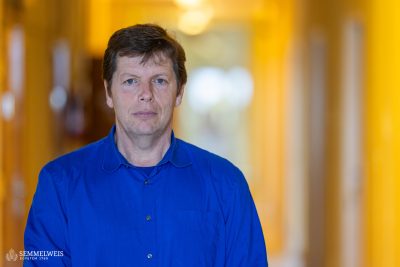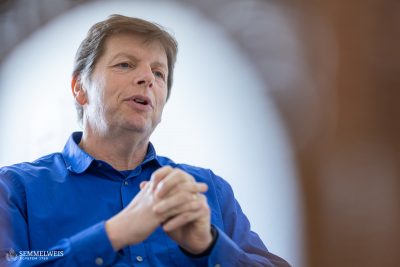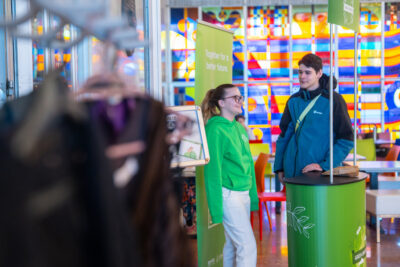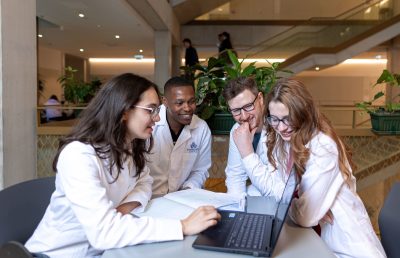A glimpse from the 19th floor of the Nagyvárad Square Theoretical Block, housing the Institute of Behavioral Sciences, leaves viewers with the impression of tranquility. Below, however, study an amalgam of Semmelweis citizens from 115 countries, joined by their dedication to learn a healing profession. Apart from this, they might differ in any or all of the cultural dimensions as defined by Geert Hofstede, Dutch social psychologist.
Hofstede’s cultural dimensions model (1980) in its refined version set the goal to describe cultures along six axes of values: Power distance (i.e. strength of social hierarchy), Individualism vs. collectivism, Uncertainty avoidance, Motivation towards achievement and success, Long-term vs. short-term orientation, and Indulgence vs. restraint (freedom of fulfilling desires), studying how these values relate to behavior.
The Intercultural Healthcare Integrated Course was launched in 2021 at Semmelweis University with the aim of satisfying undergraduates’ desire to have a platform where international students, who represent more than 50 percent of the Faculties of Medicine and Dentistry, can form interpersonal relationships with other students of the English, German, and Hungarian language programs via groupworking at the seminars. Course organizer, sociologist Bence Döbrössy was looking for a tool that can smooth those intercultural student encounters which could easily lead to misunderstandings despite the best of intentions.
“Attendee composition represents that of the faculties, so it is always a pleasure to welcome students from, to name an example, the Faculty of Health Sciences, or larger groups from the German-language program,” Assistant Lecturer Bence Döbrössy says. Although the course is structured around a curriculum, the focus of a given semester reflects the cultural background and interest of its current participants, be it questions of sports culture, alternative medicine, or certain religions. A course like this functions best if an atmosphere of ‘safe space’ is created, where sensitive topics can be discussed, experience and knowledge are shared in both directions, and less extrovert students can open up to their peers in small groups, emphasizes the course organizer, who has been teaching intercultural healthcare courses for two decades.
 The majority of attendees are second- or third-year students, so they can acquire the necessary skillset by the time they start their clinical practice. Meeting patients from other cultures can result in cross-cultural situations participants may not even be aware of. This can manifest in such fundamental questions as at what point patients perceive their condition as illness. Acquired values of one’s cultural background may influence to which symptoms society attaches significance to. Expressing complaint may vary considerably, too: some cultures are not afraid of revealing their feelings and perceptions intensively, whereas others are reluctant to consult a physician until their condition deteriorates extremely – these learned patterns make them neither hypochondriac nor masochistic. Loud talk at the waiting room may be perceived as joviality by some and deviancy by others. A crowd of relatives accompanying the patient, sitting on their bed and talking on their behalf may seem unusual for a doctor who is used to silence during the examination, but can give a sense of belonging to the patient. Calling a person in authority by their first name may be regarded as either indirectness or disrespect.
The majority of attendees are second- or third-year students, so they can acquire the necessary skillset by the time they start their clinical practice. Meeting patients from other cultures can result in cross-cultural situations participants may not even be aware of. This can manifest in such fundamental questions as at what point patients perceive their condition as illness. Acquired values of one’s cultural background may influence to which symptoms society attaches significance to. Expressing complaint may vary considerably, too: some cultures are not afraid of revealing their feelings and perceptions intensively, whereas others are reluctant to consult a physician until their condition deteriorates extremely – these learned patterns make them neither hypochondriac nor masochistic. Loud talk at the waiting room may be perceived as joviality by some and deviancy by others. A crowd of relatives accompanying the patient, sitting on their bed and talking on their behalf may seem unusual for a doctor who is used to silence during the examination, but can give a sense of belonging to the patient. Calling a person in authority by their first name may be regarded as either indirectness or disrespect.
Further cultural norms surrounding modesty, self-expression, smile and giggle, eye contact, physical distance, the concept of time, gender, age, faith, and death can be sources of potentially critical incidents.
“It is personal experience that has driven me to this topic. As a son of a renowned oncologist, growing up in Hungary, the United States and Denmark, I was immersed in an international environment. I got my sociology degrees at the University of Reading and the University of London. Throughout the three years of my BA training, it was only once that I ran into a fellow Hungarian. During my secondary school years in Denmark, my 90 schoolmates came from 60 different countries. So, I was naturally attracted to studying, and more importantly, teaching the factors influencing human coexistence,” Bence Döbrössy recalls his motives.
Case studies, often stemming from students’ personal experiences, constitute one of the main pillars of the course.
My goal is that they put themselves in others’ shoes via learning about cultures and beliefs other than their own. However, as important as the role of culture may be, I always warn my students against stereotyping, and as such, I am reluctant to give them one-size-fits-all answers.
 More important than limitless textual knowledge is the mindset course participants get introduced to. First of all, they are sensitized to cultural pluralism, which is becoming increasingly accessible with globalization. Secondly, they get to know the reliable sources of information, so that in the future they will be able to study the cultures relevant to the geographical area where they will practice their profession, and will be empowered to make informed decisions. As the course emphasizes that cultural pluralism is to be protected as long as it does not violate the rights of others, prospective medical professionals are encouraged to listen, be open-minded, ask questions, check concepts, and try to understand and speak the ‘language’ of the other cultures in an atmosphere of trust.
More important than limitless textual knowledge is the mindset course participants get introduced to. First of all, they are sensitized to cultural pluralism, which is becoming increasingly accessible with globalization. Secondly, they get to know the reliable sources of information, so that in the future they will be able to study the cultures relevant to the geographical area where they will practice their profession, and will be empowered to make informed decisions. As the course emphasizes that cultural pluralism is to be protected as long as it does not violate the rights of others, prospective medical professionals are encouraged to listen, be open-minded, ask questions, check concepts, and try to understand and speak the ‘language’ of the other cultures in an atmosphere of trust.
As a former course participant, Shanti from South Korea phrased it, “we come from a kaleidoscope of backgrounds and will train to become doctors all across the globe. A doctor is not merely an individual who robotically listens to symptoms and gives the correct diagnosis, but rather someone who responds to the patient’s healthcare needs. This also includes the psychological feeling of being ‘cared’ for.”
Judit Szabados-Dőtsch
Photo: Bálint Barta, Attila Kovács – Semmelweis University



